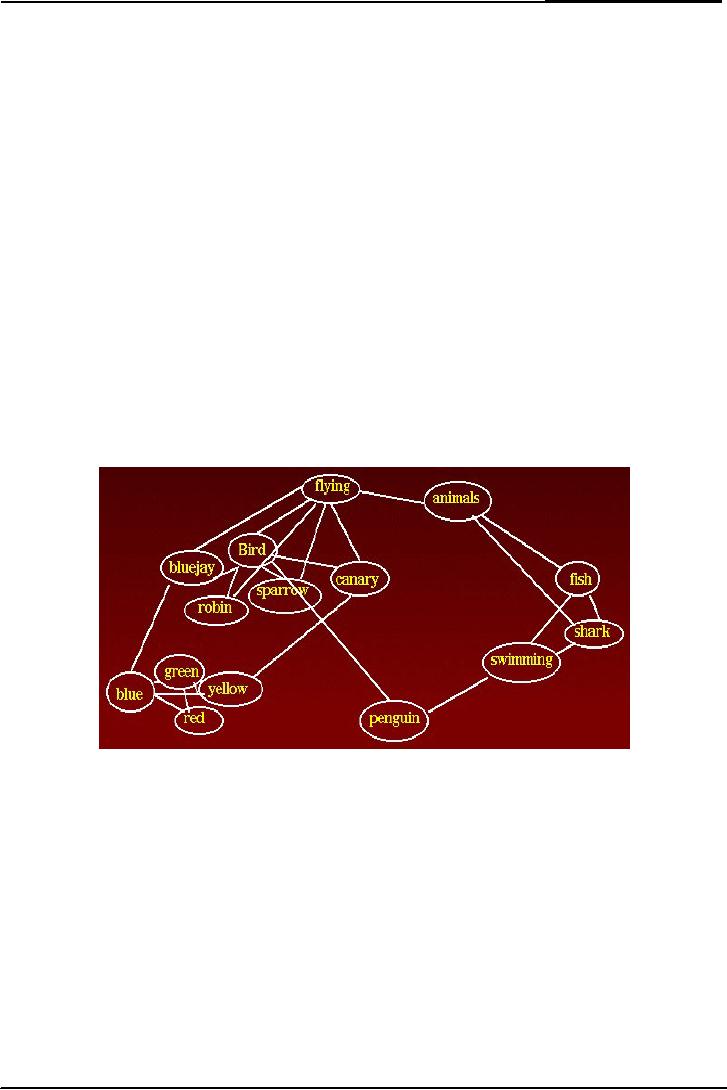 |
Memory:Are forgotten memories lost forever? |
| << Memory:Interference, Historical Memories, Recall versus Recognition |
| Memory:Recognition of lost memories, Representation of knowledge >> |

Cognitive
Psychology PSY 504
VU
Lesson
32
Memory
Long
Term Memory
Recall
versus Recognition
Eye
witness testimony or expert
witness
When
we recognize others we make
our own ways. For
example we see Chinese and
recognize
them
as Chinese because of their
small eyes and foreheads. We
also perceive black farm
people
same.
This is just because of the
things that we see common in
all black farms. So,
false
testimony
can be made by people. For
example a white man sees a
black farm man at night
then
he
thinks other black farms
are same like that
black farm.
Our
memory is inference by our
contextual clues that are
saved in our long term
memory. We use
these
clues or information from
our memory to fill our
gap.
Activation
in network
The
following figure is showing
the activation in a network.
The word penguin has
two links, one
is
bird and other is swimming.
Bird and swimming have
their links as well. If we
think about
swimming
the activation model will
become active and we can
recall penguin because of
its
connection
with swimming. So the words
are linked with other so
many words. By
remembering
one
word we can recall others as
well.
So,
in our daily life if we want
to learn things if we make
links of this information
then it become
easy
to remember or recall. For
example we want to learn an
essay of parents, we make
different
links
like father, mother, love,
affection, help, sacrifice,
food, help etc. so,
students should make
links
among information they can
easily recall information in
exams.
Even
in the case of historical
memories if we make links it
become easy to recall. For
example
you
want to recall who made or
discovered Sulfuric Acid? If we
have learnt it and make a
link with
it
that sulfuric acid was
made by Muslim scientist.
Then we can recall it
easily.
When
the students are learning
the lessons if they make a
network of all material than
they can
easily
recall it. If they make
picture of material and
learn it then it will also
help in recalling.
Because
the memory of pictures is
better and has deeper
quality to recall than for
words. Memory
for
smells is long lasting than
all other memories. For
example you take just
one drop of perfume
and
put it on the page where
you are making network.
Then it will help in
remembering the
information.
Because, the association
between interesting and
boring things makes
remembering
easy
and fast. It is called
elaborate networks
95

Cognitive
Psychology PSY 504
VU
In
all kind of material
sciences, like physics,
chemistry, biology, mathematics,
all kind of
information
becomes easy because of
these elaborate networks.
Different pictures or figures
are
also
given in books because these
figures help in remembering
things easily. Even in
subjects of
History
or Islamiyat different hierarchies
and tables are also
given.
Another
example of memory for smells
is that mostly the females
use diaries that have
smell.
Some
females or people put some
perfume on their
notebooks.
Are
forgotten memories lost
forever?
An
important issue to consider
while talking about the
memory is that whether or
not the forgotten
memories
are lost for
ever.
An
interesting possibility is that we
never do really lose our
memories that forgotten
memories are
still
there but are too
weak to be retrieved. Penfield
(1959) conducted an experiment to
report this
notion.
In
that experiment as a neurosurgical
procedure, he electrically stimulated
parts of patients'
brains
and asked them to report
what they experienced
(patients were conscious
during the
surgery
but the stimulation
technique was painless). In
this way Penfield was
able to determine
the
function of various portions of
the brain. Stimulation of
the temporal lobes led to
reports of
memories
that patients were unable to
report in normal recall, for
instance, events from
their
childhood.
It
was as if Penfield's stimulation
activated portions of the
memory network that
spreading
activation
could not reach.
Unfortunately, it is hard to know
whether the patient's memory
reports
were
accurate, since going back
in time to check on whether
the events reported
actually
occurred
was nearly impossible.
Therefore, although suggestive,
the Penfield experiments
are
generally
discounted by memory researchers.
Even so, the question of
forgotten memories
and
its
importance remains the
same.
96
Table of Contents:
- INTRODUCTION:Historical Background
- THE INFORMATION PROCESSING APPROACH
- COGNITIVE NEUROPSYCHOLOGY:Brains of Dead People, The Neuron
- COGNITIVE NEUROPSYCHOLOGY (CONTINUED):The Eye, The visual pathway
- COGNITIVE PSYCHOLOGY (CONTINUED):Hubel & Wiesel, Sensory Memory
- VISUAL SENSORY MEMORY EXPERIMENTS (CONTINUED):Psychological Time
- ATTENTION:Single-mindedness, In Shadowing Paradigm, Attention and meaning
- ATTENTION (continued):Implications, Treismanís Model, Normanís Model
- ATTENTION (continued):Capacity Models, Arousal, Multimode Theory
- ATTENTION:Subsidiary Task, Capacity Theory, Reaction Time & Accuracy, Implications
- RECAP OF LAST LESSONS:AUTOMATICITY, Automatic Processing
- AUTOMATICITY (continued):Experiment, Implications, Task interference
- AUTOMATICITY (continued):Predicting flight performance, Thought suppression
- PATTERN RECOGNITION:Template Matching Models, Human flexibility
- PATTERN RECOGNITION:Implications, Phonemes, Voicing, Place of articulation
- PATTERN RECOGNITION (continued):Adaptation paradigm
- PATTERN RECOGNITION (continued):Gestalt Theory of Perception
- PATTERN RECOGNITION (continued):Queen Elizabethís vase, Palmer (1977)
- OBJECT PERCEPTION (continued):Segmentation, Recognition of object
- ATTENTION & PATTERN RECOGNITION:Word Superiority Effect
- PATTERN RECOGNITION (CONTINUED):Neural Networks, Patterns of connections
- PATTERN RECOGNITION (CONTINUED):Effects of Sentence Context
- MEMORY:Short Term Working Memory, Atkinson & Shiffrin Model
- MEMORY:Rate of forgetting, Size of memory set
- Memory:Activation in a network, Magic number 7, Chunking
- Memory:Chunking, Individual differences in chunking
- MEMORY:THE NATURE OF FORGETTING, Release from PI, Central Executive
- Memory:Atkinson & Shiffrin Model, Long Term Memory, Different kinds of LTM
- Memory:Spread of Activation, Associative Priming, Implications, More Priming
- Memory:Interference, The Critical Assumption, Limited capacity
- Memory:Interference, Historical Memories, Recall versus Recognition
- Memory:Are forgotten memories lost forever?
- Memory:Recognition of lost memories, Representation of knowledge
- Memory:Benefits of Categorization, Levels of Categories
- Memory:Prototype, Rosch and Colleagues, Experiments of Stephen Read
- Memory:Schema Theory, A European Solution, Generalization hierarchies
- Memory:Superset Schemas, Part hierarchy, Slots Have More Schemas
- MEMORY:Representation of knowledge (continued), Memory for stories
- Memory:Representation of knowledge, PQ4R Method, Elaboration
- Memory:Study Methods, Analyze Story Structure, Use Multiple Modalities
- Memory:Mental Imagery, More evidence, Kosslyn yet again, Image Comparison
- Mental Imagery:Eidetic Imagery, Eidetic Psychotherapy, Hot and cold imagery
- Language and thought:Productivity & Regularity, Linguistic Intuition
- Cognitive development:Assimilation, Accommodation, Stage Theory
- Cognitive Development:Gender Identity, Learning Mathematics, Sensory Memory